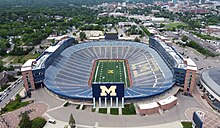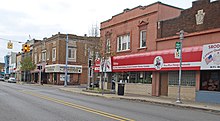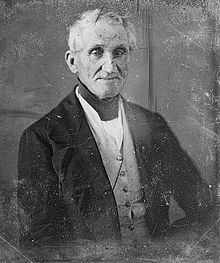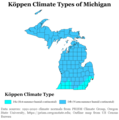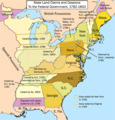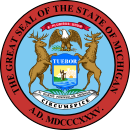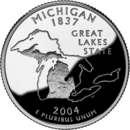Portal:Michigan
The Michigan Portal  Michigan (/ˈmɪʃɪɡən/ ⓘ MISH-ig-ən) is a state in the Great Lakes region of the Upper Midwest region of the United States. It borders Wisconsin to the northwest in the Upper Peninsula, and Indiana and Ohio to the south in the Lower Peninsula; it is also connected by Lakes Superior, Michigan, Huron, and Erie to Minnesota and Illinois, and the Canadian province of Ontario. With a population of nearly 10.12 million and an area of 96,716 sq mi (250,490 km2), Michigan is the 10th-largest state by population, the 11th-largest by area, and the largest by area east of the Mississippi River. Its capital is Lansing, and its largest city is Detroit. Metro Detroit is among the nation's most populous and largest metropolitan economies. The name derives from a gallicized variant of the original Ojibwe word ᒥᓯᑲᒥ (mishigami), meaning "large water" or "large lake". Michigan consists of two peninsulas. The Lower Peninsula resembles the shape of a mitten, and comprises a majority of the state's land area. The Upper Peninsula (often called "the U.P.") is separated from the Lower Peninsula by the Straits of Mackinac, a five-mile (8 km) channel that joins Lake Huron to Lake Michigan. The Mackinac Bridge connects the peninsulas. Michigan has the longest freshwater coastline of any political subdivision in the United States, being bordered by four of the five Great Lakes and Lake St. Clair. It also has 64,980 inland lakes and ponds. Michigan has the second-most water area of any state, behind only Alaska. The area was first occupied by a succession of Native American tribes over thousands of years. In the 17th century, French explorers claimed it as part of the New France colony, when it was largely inhabited by Indigenous peoples. French and Canadian traders and settlers, Métis, and others migrated to the area, settling largely along the waterways. After France's defeat in the French and Indian War in 1762, the region came under British rule. Britain ceded the territory to the newly independent United States after its defeat in the American Revolutionary War. The area was part of the larger Northwest Territory until 1800, when western Michigan became part of the Indiana Territory. Michigan Territory was formed in 1805, but some of the northern border with Canada was not agreed upon until after the War of 1812. Michigan was admitted into the Union in 1837 as the 26th state, a free one. It soon became an important center of industry and trade in the Great Lakes region, attracting immigrants in the late 19th and early 20th centuries from many European countries. Immigrants from Finland, Macedonia, and the Netherlands were especially numerous. Migration from Appalachia and of Black Southerners as part of the Great Migration increased in the 1930s, with many settling in Metro Detroit. Although Michigan has developed a diverse economy, in the early 20th century it became widely known as the center of the U.S. automotive industry, which developed as a major national economic force. It is home to the country's three major automobile companies (whose headquarters are all in Metro Detroit). Once exploited for logging and mining, today the sparsely populated Upper Peninsula is important for tourism because of its abundance of natural resources. The Lower Peninsula is a center of manufacturing, forestry, agriculture, services, and high-tech industry. (Full article...) Entries here consist of Good and Featured articles, which meet a core set of high editorial standards.
Michigan Stadium, nicknamed "The Big House," is the football stadium for the University of Michigan in Ann Arbor, Michigan. It is the largest stadium in the United States and the Western Hemisphere, the third-largest stadium in the world, and the 34th-largest sports venue in the world. Its official capacity is 107,601, but it has hosted crowds in excess of 115,000. Michigan Stadium was built in 1927 at a cost of $950,000 (equivalent to $13.4 million in 2023) and had an original capacity of 72,000. Prior to the stadium's construction, the Wolverines played football at Ferry Field. Every home game since November 8, 1975 has drawn a crowd in excess of 100,000, an active streak of more than 300 contests. On September 7, 2013, the game between Michigan and the Notre Dame Fighting Irish attracted a crowd of 115,109, a record attendance for a college football game since 1948, and an NCAA single-game attendance record at the time, overtaking the previous record of 114,804 set two years previously for the same matchup. (Full article...)Selected picture - The Little Sable Point Light is located south of Pentwater in the U.S. state of Michigan. It is in the southwest corner of Golden Township, just south of Silver Lake State Park. Did you know -
Related portalsSelected article -Hamtramck (/hæmˈtræmɪk/ ham-TRAM-ik) is a city in Wayne County in the U.S. state of Michigan. An enclave of Detroit, Hamtramck is located roughly 5 miles (8.0 km) north of downtown Detroit, and is surrounded by Detroit on most sides. As of the 2020 census, the city had a population of 28,433, and was by far the most densely populated municipality in Michigan. It is notable as the only Muslim-majority city in the United States. Known in the 20th century as a vibrant center of Polish-American life and culture, Hamtramck has attracted new immigrants in the 21st century, especially from Yemen, Bangladesh and Pakistan. In 2013, it reportedly became the first Muslim-majority city in the U.S. In 2015, Hamtramck became the first city to have a Muslim-majority city council in the history of the United States, with four of the six council members being Muslim. (Full article...)Selected biography -
Hugh Brady (July 29, 1768 – April 15, 1851) was an American general from Pennsylvania. He served in the Northwest Indian War under General Anthony Wayne, and during the War of 1812. Following the War of 1812, Brady remained in the military, eventually rising to the rank of major general and taking command of the garrison at Detroit. He also marginally participated in the 1832 Black Hawk War. Hugh Brady died an accidental death in 1851 when he was thrown from a horse-drawn carriage. (Full article...)
General imagesThe following are images from various Michigan-related articles on Wikipedia.
TopicsCategoriesSymbols
Lists
Related pagesWikimediaThe following Wikimedia Foundation sister projects provide more on this subject:
Things you can doDiscover Wikipedia using portals | ||||||||||||||||||||||||||||||||||||

